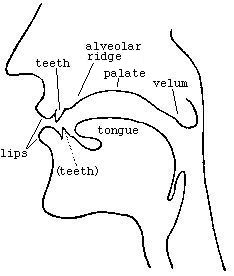 back to consonants
back to consonants back to course outline
back to course outline
Consonants: place of articulation 
By Place of Articulation we mean where the constriction occurs in the mouth, and how the parts of the mouth - lips, teeth, tongue, palate and so on - work together.
You should study a good diagram of the vocal tract with the names of the various parts of the mouth that are important for articulation - the articulators - for instance Roach p. 8, reproduced here with some changes:
 Remember the following points:
Remember the following points:
- bilabial (two-lipped) consonants, p, b: both lips come together
- labio-dental (lip-tooth) consonants, f, v: the lower lip and upper teeth make contact
- dental consonants, þ, ð: the tongue makes contact with the upper teeth
- alveolar consonants, t, d, s, z : the tip of the tongue makes contact with the alveolar ridge
- post-alveolar consonants,
 ,
,  ,
,  ,
,  : the tongue makes contact with the roof of the mouth a little further back than the alveolar ridge
: the tongue makes contact with the roof of the mouth a little further back than the alveolar ridge
- r is also a post-alveolar consonant, although the tongue does not touch the roof of the mouth
- palatal consonant s - in English the only palatal consonant is j : the tongue approaches the palate
- velar consonants, k, g: the back of the tongue makes contact with the velum
- glottal fricative h - this is really an unvoiced vowel
 back to course outline
back to course outline
 back to Phonetics
back to Phonetics
 back to Pétur Knútsson's home page
back to Pétur Knútsson's home page
If you have any questions mail me at peturk@hi.is.
 Remember the following points:
Remember the following points: